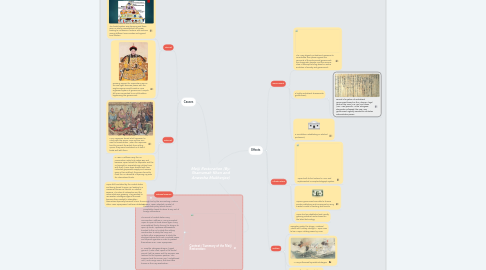
1. Causes
1.1. Internal
1.1.1. The feudal system was decaying and there were no strong consolidations of power leading to increases in factions and mutinies among different communities and against local leaders.
1.1.2. Growing support for imperialism was on the rise again because power with the single emperor would create a more organized system of government. People felt more connected to an old tradition legitimizing the government.
1.2. External
1.2.1. Many Japanese feared what happened in China with the opium crisis and war as a result of Great Britain. When the Japanese tried to prevent the British from selling opium, they were humiliated, so it didn’t bode well with them.
1.2.2. In 1853, Matthew Perry, the US commodore, sailed into Tokyo Bay, and because Japan lacked the firepower and the US brought an overwhelming military force with them (4 war ships stocked with near unlimited gunpowder supply and massive guns in their artillery), they were forced to meet the US demands of opening up ports for international trade.
1.3. National Essence
1.3.1. Japan felt humiliated by the United States and being forced to open up, leading to a movement known as kokutai, or national essence. The idea of nationalism and the nation-state was growing. They wanted to use western strategies against the west, because they needed to strengthen themselves especially because, China, the other Asian superpower had been defeated.
2. Context / Summary of the Meiji Restoration:
2.1. Brought on by the encroaching Western powers, Japan adopted a model of closed-door policy which almost completely closed its doors to any sort of foreign interactions.
2.2. The arrival of United States Navy Commodore Matthew C. Perry prompted Japan to open its trade doors again. Perry accomplished this by forcing the shogun to open up trade. Japanese ambassadors traveled to the US to study the military, Great Britain to study the navy, and multiple other superpowers to study the strongest elements of each countries power and imperial agendas in order to present themselves as an Asian superpower.
2.3. In 1868 the Tokugawa shôgun ("great general"), who ruled Japan in the feudal period, lost his power and the emperor was restored to the supreme position. The emperor took the name Meiji ("enlightened rule") as his reign name; this event was known as the Meiji Restoration.
3. Effects
3.1. Government
3.1.1. The Meiji oligarchy introduced measures to consolidate their power against the remnants of the Edo period government, the shogunate, daimyo, and the samurai class in attempt to bring about an entire evolution of society and government.
3.1.2. a highly centralized, bureaucratic government;
3.1.2.1. Revival of a system of centralized government based on the “ritsuryo” legal code of the Nara (710-794) and Heian (794-1185) periods. As the Tokugawa shogunate collapsed, the new Meiji government urgently needed to centralize administrative power.
3.1.3. a constitution establishing an elected parliament;
3.2. Infrastructure
3.2.1. Japan built its first railroad in 1872 and implemented a complex telegraph system.
3.2.2. Japan’s government was able to finance private institutions and companies by using a British model of banking and finance.
3.2.3. Japan had an established and rapidly growing industrial sector based on the latest technology
3.3. Military
3.3.1. Operating under the slogan “National Wealth and Military Strength,” Japan rose to be a major military power by 1905.
3.3.2. A navy influenced by British strategies
3.3.3. An army influenced by US strategies
